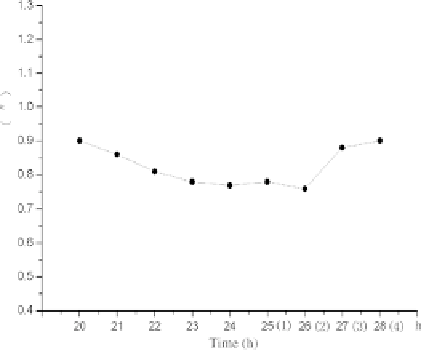Geoscience Reference
In-Depth Information
Fig. 3.
Seeing changes symmetrically to midnight.
Orbital parameters and spectrum of an asteroid can be obtained by large
ground-based telescopes. But it is only applicable to big and bright objects.
Asteroid observation and investigation in space has been realized by sev-
eral flybys and single body missions, e.g., NEAR,
1
Hayabusa (Muses-C).
2
Recent years, based on advanced instruments and auto-navigation system,
space missions for asteroid flux, category, and size distribution are proposed.
Bering
3
,
4
proposed by Danmark aims at main belt asteroids. The orbit is
0.72-3.5 AU. The EUNEOS
5
proposed by France is to explore NEOs and
PHOs. The orbit is 0.5-0.72 AU.
In our ASTROD I mission
6
proposal for studying precision astrody-
namics, the mission orbit of the spacecraft is designed to reach between the
orbits of Venus and Mercury after two Venus encounters. From the expe-
rience in the ASTROD I orbit design, there could be various choices for
the orbit of the asteroid exploration spacecraft to combine the two goals
of Bering and EUNEOS in one space exploration. Figure 4 is the designed
orbit of ASTROD I.
Our asteroid exploration scheme can be: after two encounters with Venus
to reach an orbit between that of Venus and Mercury to observe inner aster-
oids for some time, the spacecraft encounters with the Venus for the third
and fourth times and Earth once to reach the asteroid belt. Before reaching
asteroid belt, the spacecraft can discover and explore the asteroids in the
area from Mercury orbit to asteroid belt, especially NEOs and asteroids
across Mars. After reaching the main asteroid belt, its main object is to










